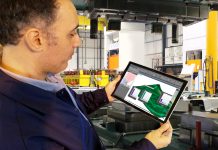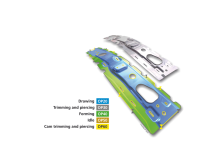
Whenever planning sheet metal stamping products and processes, the goal is always to design the “optimum” process. However, the search for the optimum is a challenge that the entire stamping industry faces. Is the optimum process one that delivers perfect parts, or the process with the lowest tooling cost, or the stamping method that utilizes the least amount of material? Throughout the manufacturing community most would agree that they want the best parts with the highest attainable quality, at the lowest cost, with minimized material usage in time for the product launch. What is not so easily agreed upon is the path to achieve these goals, or the prioritization used to weigh one’s decisions if the goals suggest conflicting solutions.

Selecting which forming process often requires compromise between the decision drivers
To define what the optimum is, one must consider more than one dimension for evaluation. When shopping for a flight for an upcoming holiday, you consider your own situation in finding the optimum purchase. In these situations thinking about an “objective best” has almost no merit. Is it best to find the most direct flight? Perhaps that is very expensive. How about a cheap flight with several layovers in distant airports? Or do we book the flights to airports a little further from our final destination in order to have preferred airline partners or higher quality service? When considering your own vacation, you find it prudent to weigh several options where you compare time, cost, and subjective quality to decide which flight you might book.
In the same way that everyday decisions – like vacation planning – require evaluation of multiple decision drivers spanning more than one dimension, so too our engineering decisions must be based on more than one dimension for evaluation. It is no longer enough to define the BEST forming process as the first one that passes simulation; just as it is no longer acceptable to determine the best forming process by building soft tool concepts until we found one that “held water” after drawing. Tomorrow’s forming processes require that we look beyond the mesh, past the simulated stress and strain, in order to determine the level of repeatability expected for a forming process and the relative cost of achieving the quality and repeatability that we predict.
To evaluate every possible process or process variant was, in the past, not possible. Building prototype/proof tools and trying them out, or later setting up multiple simulations to analyze any benefits of the process alternatives was just not feasible. However, with today’s computer processing power alternate processes are easily investigated, allowing us to go far beyond our first-hand experiences. In fact, we believe that forming simulation has reached the level of maturity where it is too costly not to validate process variants that we discarded as “impractical” based purely on prior experience.

A sheet metal component with a “backdraft” condition in the flange
With the advances made in simulation and die face modeling technology over the past decades, it is easier than ever to simulate a proposed process and assess if the process is likely to produce parts. Using innovative feature-based techniques we can predict which process is likely to generate the highest tooling costs. We can predict—long before any tools are cut, even before the 3D CAD-CAM tooling model is prepared—whether a proposed stamping process will repeat under typical production variation or not.

Two possible processes: Direct trim developed flange on binder or Cam trim developed flange on punch
Merely knowing that a proposed stamping process passes using a single simulation will no longer differentiate you from your competitors. To truly advance the industry we need to know what tooling, material, or production costs are associated with a predicted level of sheet metal quality. If a proposed process creates increased or decreased costs, or adversely affects repeatability and reliability, or lowers product functionality there should be a way to assess that impact. It all begins with considering that there may be process alternatives and with evaluating that process objectively.

Either process with design effort and simulation could eventually work; which is optimum?
At AutoForm we endeavor to develop solutions to support this more comprehensive engineering methodology. Our solutions portfolio addresses every stage of the sheet metal forming value stream from product design through serial production. With our solutions, we aim to address sheet metal quality, tooling and production costs, production ramp up time and stamping process robustness.
Please visit again as we continue to address this concept in a series of posts on this blog.













